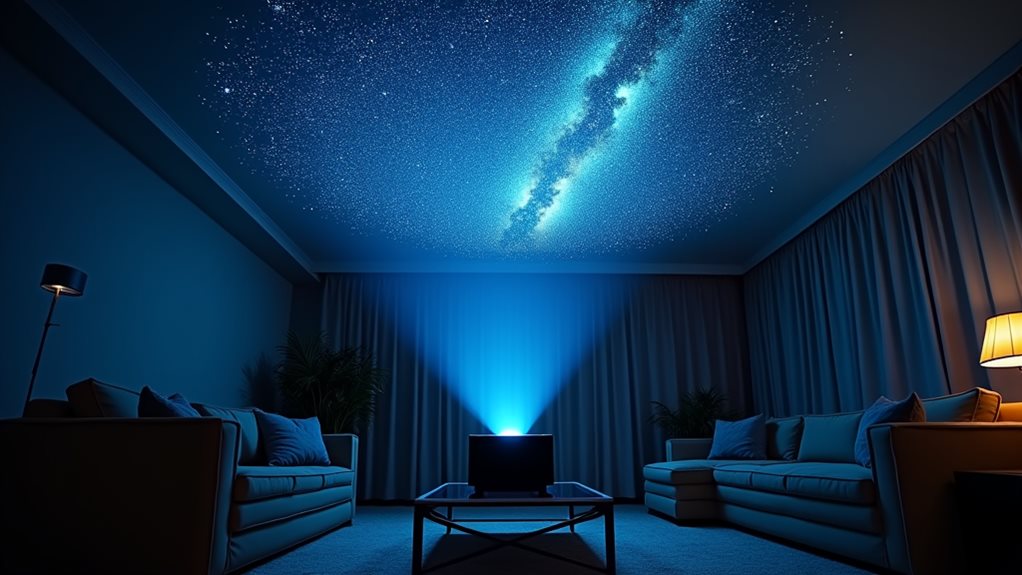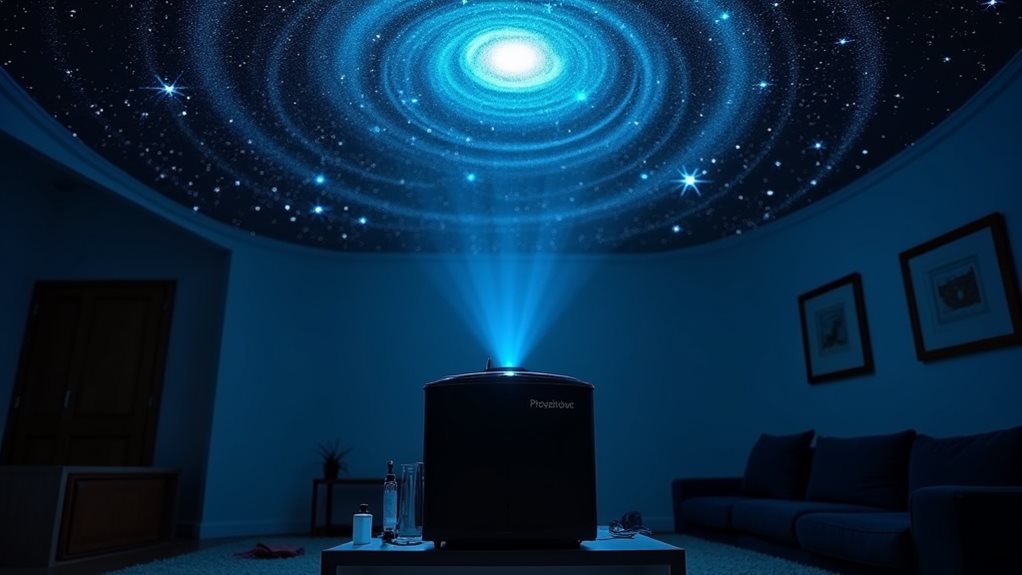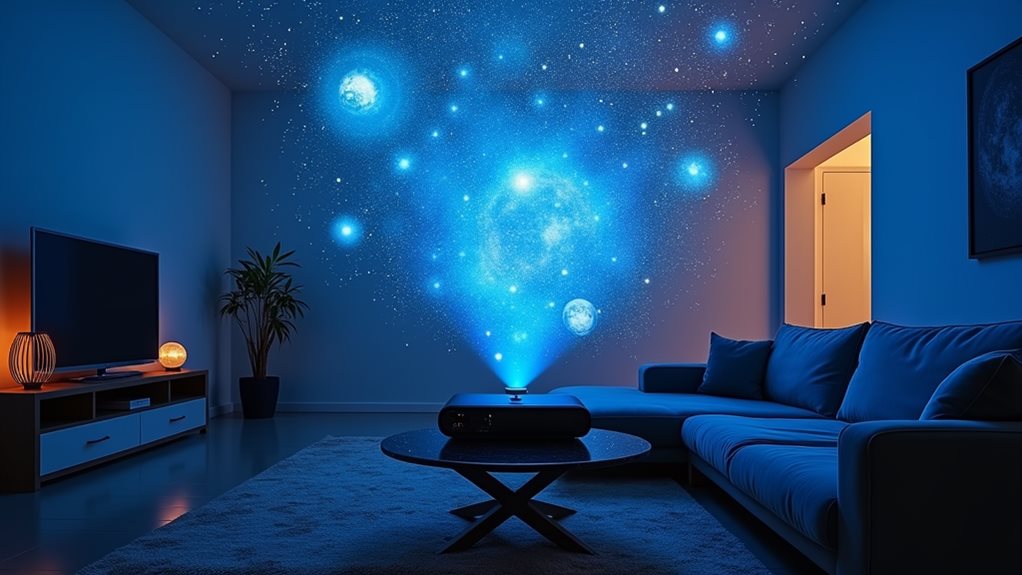Transform your living space into a personal astronomical theater with a home planetarium system that brings the cosmos to life. You’ll discover options ranging from basic manual models to advanced digital projectors featuring 60,000+ stars, interactive features, and immersive sound effects. With proper setup, including blackout curtains and ideal positioning, you can create stunning celestial displays. Regular maintenance guarantees peak performance, while strategic upgrades enhance your stargazing experience. The universe of possibilities awaits your exploration.
Understanding Home Planetariums: From Basic to Advanced Models

The evolution of home planetariums has transformed how we experience the cosmos from the comfort of our living rooms.
Whether you’re exploring basic models with mechanical projectors or diving into advanced technology featuring LED displays, you’ll find options that match your astronomical aspirations.
If you’re just starting out, you’ll appreciate how basic models offer manual controls and cost-effective ways to learn about celestial movements. Drawing from a century of innovation since the first projection planetarium in 1923, modern home units continue to advance in quality and functionality. The Trippensee Basic Planetarium features a chain drive mechanism that accurately demonstrates planetary motions. Moreover, today’s models come equipped with optional discs that enhance the projection experience by providing varied celestial themes.
These entry-level planetariums, while limited in resolution, provide essential educational value for understanding fundamental astronomy concepts.
For those seeking a more immersive experience, today’s advanced systems deliver high-resolution displays, motorized controls, and even 3D capabilities.
You’ll discover that modern home planetariums aren’t just educational tools – they’re gateways to the universe, offering both detailed astronomical insights and entertainment value through upgradeable content and interactive features.
Essential Features to Look for When Buying Your Planetarium
When searching for your perfect home planetarium, you’ll need to navigate through a maze of features that can make or break your stargazing experience.
Start by examining the projector technology and star accuracy – you’ll want a system that displays at least 60,000 stars with crystal-clear resolution. For optimal viewing pleasure, ensure you have complete darkness in your room.
Consider practical features that enhance your viewing freedom: adjustable focus settings, multiple projection discs for both hemispheres, and the flexibility to power your unit through various sources. A quality projector like the Sega Homestar Flux includes detailed sky maps to help identify constellations, allowing for a more immersive experience with high-definition projections.
Don’t overlook the importance of build quality and noise levels – you won’t want a distracting hum interrupting your celestial experience.
The best models offer additional perks like shooting star effects and nature sounds, transforming your space into a personal observatory.
Setting Up Your Home Planetarium for Optimal Performance

Setting up your home planetarium doesn’t need to be an intimidating task, as most modern units can be operational within three minutes.
You’ll encounter minimal setup challenges if you follow a systematic approach: start by connecting your power source, insert your preferred disc, and position the projector correctly.
To overcome common adjustment tips, verify you’ve got proper ventilation and a sturdy support structure for your dome. Using flat matt grey paint on interior surfaces helps optimize image quality. For optimal functionality, ensure your device has illuminated buttons for nighttime adjustments. Additionally, it’s wise to consider projection quality features to ensure a vibrant display.
You’re free to customize your experience with various disc options, including sky views and Aurora displays.
For the best viewing experience, position yourself below the dome’s baseline and manage power cables safely.
If you’re feeling adventurous, you can enhance your setup with features like automatic shutdown timers or a rotating mechanism to simulate actual celestial movement.
Creating the Perfect Indoor Stargazing Experience
Creating a perfect indoor stargazing environment requires careful attention to both technical and comfort-related details.
You’ll want to start by selecting an area that’s shielded from city lights and equipped with blackout curtains to control light pollution. When implementing your stargazing techniques, position your telescope on a stable platform and incorporate celestial decor like glow-in-the-dark stars to enhance the ambiance. A portable red flashlight is essential for maintaining your night vision while moving around your observation space. A dome-shaped screen mounted on your ceiling can provide an immersive viewing experience, creating a mini-domed home planetarium atmosphere.
Don’t overlook comfort – you’ll spend hours exploring the cosmos, so invest in cozy seating and temperature control solutions.
Consider adding a planetarium projector to complement your viewing experience, and keep essential tools like star maps or astronomy apps within reach.
For the ultimate experience, create a dedicated refreshment station with warm drinks and snacks, transforming your space into a personal astronomical sanctuary.
Maintaining and Upgrading Your Home Planetarium System

To keep your home planetarium performing at its best, an all-encompassing maintenance and upgrade strategy is essential. Start with basic maintenance techniques like sealing light leaks and implementing regular cleaning schedules to guarantee peak performance. Regularly check that the LED light source remains bright and functional, as it’s crucial for creating clear star projections. Additionally, regular cleaning of the lens and internal components will further enhance your stargazing experience. You’ll also want to conduct periodic inspections for any wear and tear that might affect your stargazing experience.
When you’re ready to take your setup to the next level, consider various upgrade options that’ll transform your celestial viewing. You might opt for a digital projector upgrade, enhance your sound system, or install automated controls for seamless operation. Don’t forget to plan for future expansion by choosing components that are compatible with newer technologies. Remember to maintain a budget for both routine maintenance and potential upgrades, ensuring your home planetarium continues to deliver stellar performances for years to come.
Frequently Asked Questions
Can Home Planetariums Trigger Seizures in People With Photosensitive Epilepsy?
Yes, if you have photosensitive triggers, home planetariums can cause seizures. You’ll want to take seizure precautions like using newer models, maintaining safe distances, and adjusting brightness levels for your safety.
Are Home Planetariums Safe to Use Around Pets?
You’ll need to be mindful of pet safety since home planetariums can affect animals with light sensitivity. Keep pets supervised, provide a quiet retreat space, and watch for signs of stress during use.
Do Home Planetariums Significantly Increase Electricity Bills?
Don’t worry about your electricity bills – home planetariums have minimal energy consumption. You’ll barely notice any difference in costs, as they use less power than a standard LED bulb for your nightly stargazing adventures.
Can Multiple Planetariums Be Synchronized for Larger Spaces?
You can synchronize multiple planetariums for larger spaces using advanced control systems. Modern synchronization methods let you expand your setup across rooms, while dedicated software guarantees seamless coordination between all projection units.
Will Home Planetariums Work Effectively on Textured or Popcorn Ceilings?
You’ll face some projection quality challenges on textured surfaces, but don’t let that stop you. Using short throw projectors and adjusting distances can help achieve decent ceiling compatibility despite popcorn or textured finishes.
Final Thoughts
You’ve now got all the tools needed to transform your living space into an enchanting celestial theater. Whether you’re choosing a basic model or investing in advanced features, your home planetarium offers endless opportunities for exploration and wonder. Remember to maintain your system regularly, optimize your viewing conditions, and don’t hesitate to upgrade as technology evolves. With proper care and setup, you’ll enjoy countless nights under your personal galaxy.

